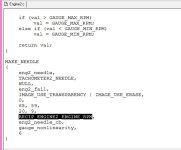Mick
SOH-CM-2025
I have a question about gauges. It relates to an aircraft that David and I are working on.
Since neither of us are helicopter experts, we're deriving our flight model from one that's known to work well, making the required changes to adapt it to the new model. So far, so good, except for one annoying little glitch.
The flight model we started with is from a single piston engined aircraft, and our model is of a twin. On the panel we have all the usual engine instruments paired up. The necessary edits were made to the engine sections of the aircraft.cfg file so that the engines start in sequence (rather than simultaneously) and the start-up smoke comes from the engines' separate exhaust stacks at the proper times, so FS9 "knows" that the aircraft is a twin.
To replace each single engine instrument I found paired instruments meant for twin engine use. For example, for the tachometers I found gauges with names like WhizzerRPM1 & WhizzerRPM2, or WhateverRPM & WhateverRPM_001 and the like.
Here's the thing - they both report the status of engine1. I expected that they were programmed to respond to separate engines, so that, for example, WhizzerRPM1 would report for engine1 and WhizzerRPM2 would report for engine 2, but nooooo - they both respond to engine1.
I thought they would do this automatically, as per their internal programming, and since I can find nothing in the aircraft.cfg file or the Air file that would allow this to be changed, that would seem to confirm the idea that they should do it on their own. But they don't.
Can someone tell me how to get the gauges to report on engine2
It's not critical since the engines are synchronized once they're running, and there's no reason to ever operate them independently, but it would be nice to see the instruments showing the staggered start-up sequence.
Since neither of us are helicopter experts, we're deriving our flight model from one that's known to work well, making the required changes to adapt it to the new model. So far, so good, except for one annoying little glitch.
The flight model we started with is from a single piston engined aircraft, and our model is of a twin. On the panel we have all the usual engine instruments paired up. The necessary edits were made to the engine sections of the aircraft.cfg file so that the engines start in sequence (rather than simultaneously) and the start-up smoke comes from the engines' separate exhaust stacks at the proper times, so FS9 "knows" that the aircraft is a twin.
To replace each single engine instrument I found paired instruments meant for twin engine use. For example, for the tachometers I found gauges with names like WhizzerRPM1 & WhizzerRPM2, or WhateverRPM & WhateverRPM_001 and the like.
Here's the thing - they both report the status of engine1. I expected that they were programmed to respond to separate engines, so that, for example, WhizzerRPM1 would report for engine1 and WhizzerRPM2 would report for engine 2, but nooooo - they both respond to engine1.
I thought they would do this automatically, as per their internal programming, and since I can find nothing in the aircraft.cfg file or the Air file that would allow this to be changed, that would seem to confirm the idea that they should do it on their own. But they don't.
Can someone tell me how to get the gauges to report on engine2
It's not critical since the engines are synchronized once they're running, and there's no reason to ever operate them independently, but it would be nice to see the instruments showing the staggered start-up sequence.
Last edited:




